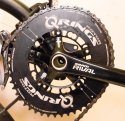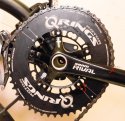ReklinedRider
Zen MBB Master
Looks correct. Sounds correct.
So you will be using the bolt closest to the dérailleur as you OCP Bolt.
Good, that's a relief. Thanks for taking a look at it.
And yes the bolt closest to the dérailleur in that pic will be my OCP bolt.
Here's another question if you can stand more on this topic: what is the actual use of the other OCP settings? If I wanted to tweak towards easier acceleration/less of a masher position, would i need to rotate the ring so that the 3 hole is at the bolt hole which is currently occupied by the 2 hole? Is that what Rotor means by "rotate the chainring to a higher OCP number"-- putting the 3 at "my OCP bolt" instead of the 2?
Could i just rotate the ring a bit counterclockwise and accomplish the same thing? Or is there magic in rotating clear around to the higher marked hole?
Or conversely to shift towards higher top speed.... Move the 1 hole to the OCP bolt, or just rotate the ring further clockwise?
I know that's down the road if ever, just trying to get some understanding of the principle(s) behind these rings so I can think it through and not just be following a rote procedure.
Seeing battleaxe0's setup is encouraging too.








